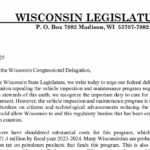By Brian Fraley, a Perspective Column for Dairyland Sentinel
Wisconsin Needs the National Guard on Standby Now
As storm clouds of unrest loom over Wisconsin this week, Governor Tony Evers faces a defining moment. The scars of 2020 in Madison and Kenosha linger—burned businesses, shattered windows, lives lost, and communities gripped by fear. Those chaotic days taught us that unchecked protests can spiral into violence and cost lives and livelihoods. To prevent history from repeating itself, Evers must place sufficient numbers of the National Guard on standby for the next week.
In 2020, Wauwatosa offered a contrasting lesson to Madison and Kenosha. In Tosa, strong, locally driven planning and mutual aid between neighboring police departments, bolstered by a well-coordinated National Guard deployment, kept chaos at bay. Adequate numbers of trained personnel, strategically positioned, ensured protests remained largely peaceful and property damage was minimized. This model of preparedness worked because it prioritized de-escalation and protection over reaction. Wauwatosa’s mayor Dennis McBride focused on keeping the peace, not on the message obvious signs of preparedness might send.
Wisconsin needs that foresight now.
Governor Evers has voiced strong objections to President Trump’s recent decision to send the National Guard to California without Governor Newsom’s request, calling it a dangerous overreach of federal power. His concerns about state sovereignty spark worthy discussion, and opinions on Trump’s immigration policies (whether perceived as necessary or draconian) remain contentious. But one truth transcends these debates: the safety of Wisconsin’s people and property must come first. We cannot let ideological battles blind us to the urgent need for order.
Thanks to social media and crowdfunding apps, today’s protest movements are rarely spontaneous outbursts of local anger. They are often highly organized, well-funded, and infiltrated by those who thrive on anarchy. These agitators exploit genuine passions (be they grievances over policy, perceived inequality, or belief in unequal justice) to ignite chaos.

The 2020 unrest in Kenosha showed how quickly things can escalate: over $50 million in damages devastated the city, with 100 businesses impacted, many of which closed permanently. City property losses hit $2 million, with garbage trucks, streetlights, and traffic signals destroyed. The Uptown neighborhood suffered $11 million in fire damage. That’s three years’ worth of typical fire losses. Apartments above shops burned, leaving dozens homeless. Small business owners lost not just livelihoods but personal belongings.
The governor should not buy into the argument that police and National Guard presence inflames already tense situations. It’s not only insulting to the professionalism of law enforcement and our Guard units, it underestimates the emotional intelligence of those on all sides of the immigration debate.
By placing the National Guard on standby, Evers can signal Wisconsin’s preparedness. This isn’t about stifling free speech; it’s about ensuring peaceful exercises of free speech don’t become pretexts for violence. Waiting until chaos erupts is a gamble we cannot afford.
Governor Evers, please learn from 2020’s mistakes. Announce the National Guard will be on standby for at least the next seven days. Coordinate with mayors of communities expecting large protests. Act now—don’t dither and react later.
By leading proactively, you can, at a minimum, reduce response times in the event you activate the Guard; and you can show that public safety outweighs politics.
Originally published 7:40 pm, Monday, June 9, 2025












